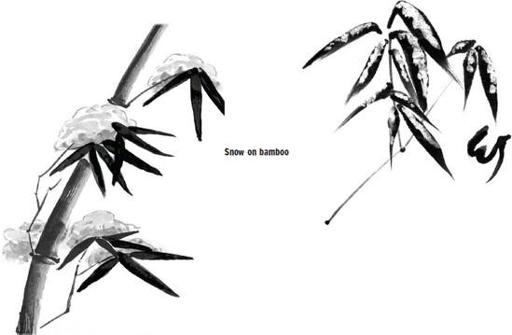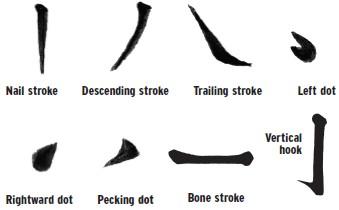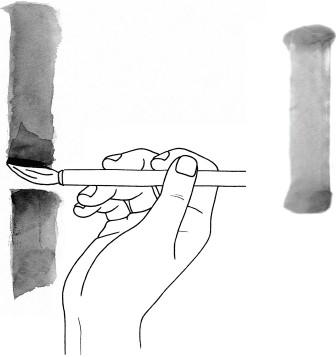Chinese Brush Painting (14 page)
Read Chinese Brush Painting Online
Authors: Caroline Self,Susan Self

Painting a Bud
Where you have a small space between leaves, you can put in a bud instead of a full flower. An orchid bud looks like a flower with shorter petals.

1.
Load the large brush with the medium light mix of paint.
2.
Paint the bud as two pale commas, using the same strokes as for the short petals.
Usually the Hsu orchid, where all the blossoms are on one stem, has a bud on the stem near the root, as it is the last to bloom. Above are some variations on buds, at different degrees of opening.
Using Rice Paper
After you have painted all the parts that make up the orchid plant on newsprint, practice on rice paper. See how the paint oozes out differently on the rice paper. Rice paper has a smooth side and a rough side. You will find that it is easier to control the paint on the smooth side. Remember to tap the brush on a paper towel to remove excess water before making a stroke on rice paper.
Painting
Bamboo

Bamboo is the most familiar subject in Chinese culture and art. It belongs to two sets of classic subjects: the Four Gentlemen and also the Three Friends of Winter, which are bamboo, plum blossom, and pine. Bamboo expresses the will to survive. Its stalks resist strong winds; they bend but never break. The wind whistling through bamboo is called the music of the gods.
This chapter follows the traditional style of using black and grays to paint bamboo. The strokes have been perfected over many centuries until they show the true spirit of bamboo. This style began when some talented old master painters showed their art. Their paintings were so admired that other artists copied them because they thought they showed the best way to paint bamboo.


Brush Styles
Bamboo can be painted in either boned or boneless styles or in a mix of the two. The favorite style, which we will use, is to do the entire painting in boneless style.


Viewing Bamboo
There are many species of bamboo and over 100 varieties. Leaves can grow upward from the stalk or downward in clusters off small branches. The most traditional style is the one with clusters of leaves. Bamboo is painted blowing in the wind, in front of the moon, or with snow on its leaves. When it rains, bamboo leaves curl up to let the rain drip off.
Painting Bamboo Stalks
The strokes used for painting bamboo are some of the same basic strokes you learned earlier in the character for “eternity.”


The bamboo stalk is made mainly by using the basic bone stroke in a vertical direction. The Chinese name of the bone stroke means “go forward and go back,” which is what the brush is doing.
Go back to the chart of basic strokes in the calligraphy chapter and review how the strokes are made. Make believe your finger is a brush making the bone stroke. Move it to the left and stop; move right and stop; and move left. Notice how the stroke ends are covered.
To paint the bamboo stalk, you make the bone stroke with the side of the brush going up and down rather than left to right. Again, practice with your finger as the brush. This time push down, then up 4 inches, and then swing your arm down again. The feel of swinging your arm down and up in a short space of time is important.
When you paint the bone stroke for the bamboo stalk, hold your hand in position #2, shown right. This means you rotate your hand to the right so the hairs of the brush are on the paper and the tip is pointing left. With a dry brush, lay the hairs down on the paper and drag it toward your body. Try to keep the heel of the brush (where the hairs join the handle) down on the paper. This will help to make a straight line on the right side of the bamboo stalk.
Painting Bamboo Stalk Sections
Now try to paint a section of bamboo stalk with the bone stroke using brush and paint. The stalk sections are painted starting from the bottom of the page and moving upwards.
1.
Mix a large dish of medium light mix. Test it on the mixing plate.
2.
Load the brush by rolling all of the hairs forward and back in the dish so that every hair has paint.
3.
Rotate your hand to the right and press the whole brush down, especially the heel of the brush. Push down with your arm, stop, push up 4 inches, stop, and push your arm and brush down slightly to end the stroke. Notice that you have made a darker area at the top and bottom of the section. This is the growth ring on the bamboo stalk.
4.
Stop and look at the stroke. Does it have a straight edge on the right side? Is the width of the stroke even? Try it again many times.
To make an entire stalk
, start with the bottom section and keep adding sections above it. The sections of the bamboo are painted the way they grow. The sections at the bottom are closer together, and as the plant gets taller, each section is a little longer. So paint each section slightly longer than the one below it.
1.
To make the lowest section, load the brush and lay it down on the paper 2 inches above where the ground would be for the bamboo. Push up with your arm, stop, push down 3 inches and off the page. Notice the darker area at the top of the section and the lighter area at the bottom where the stalk grows in the ground.

